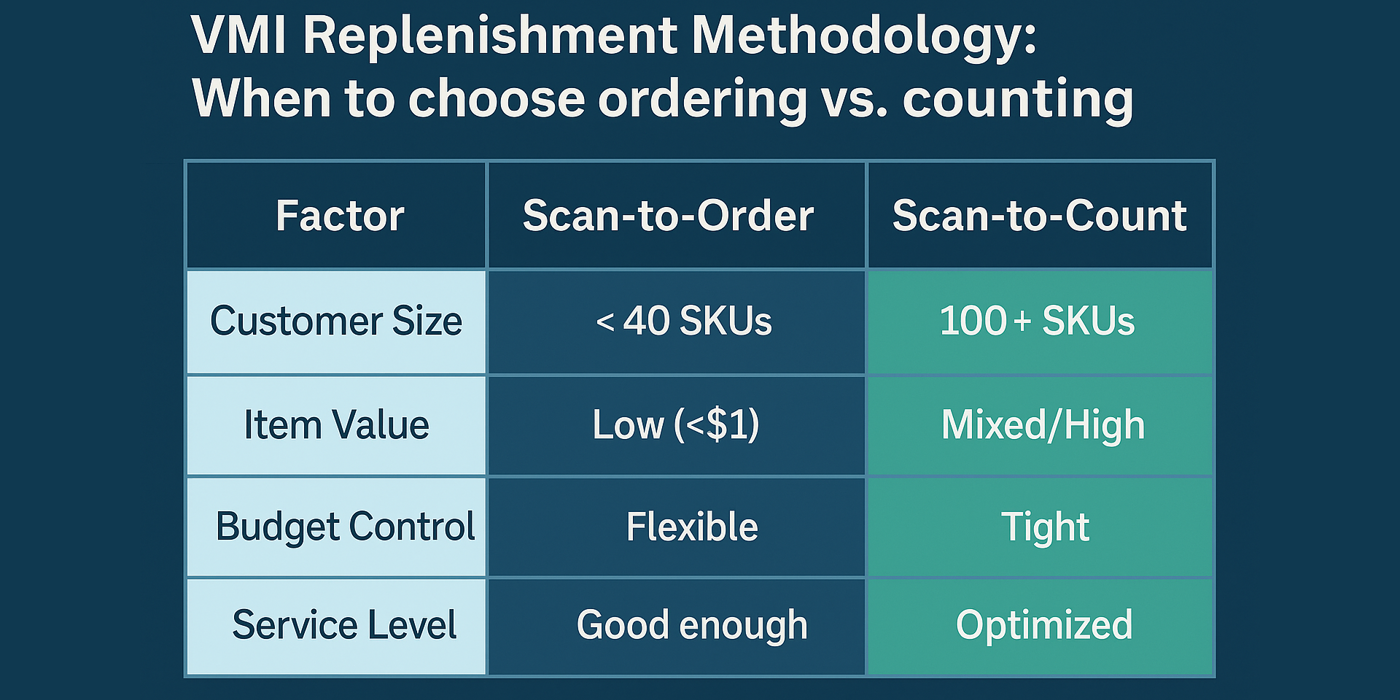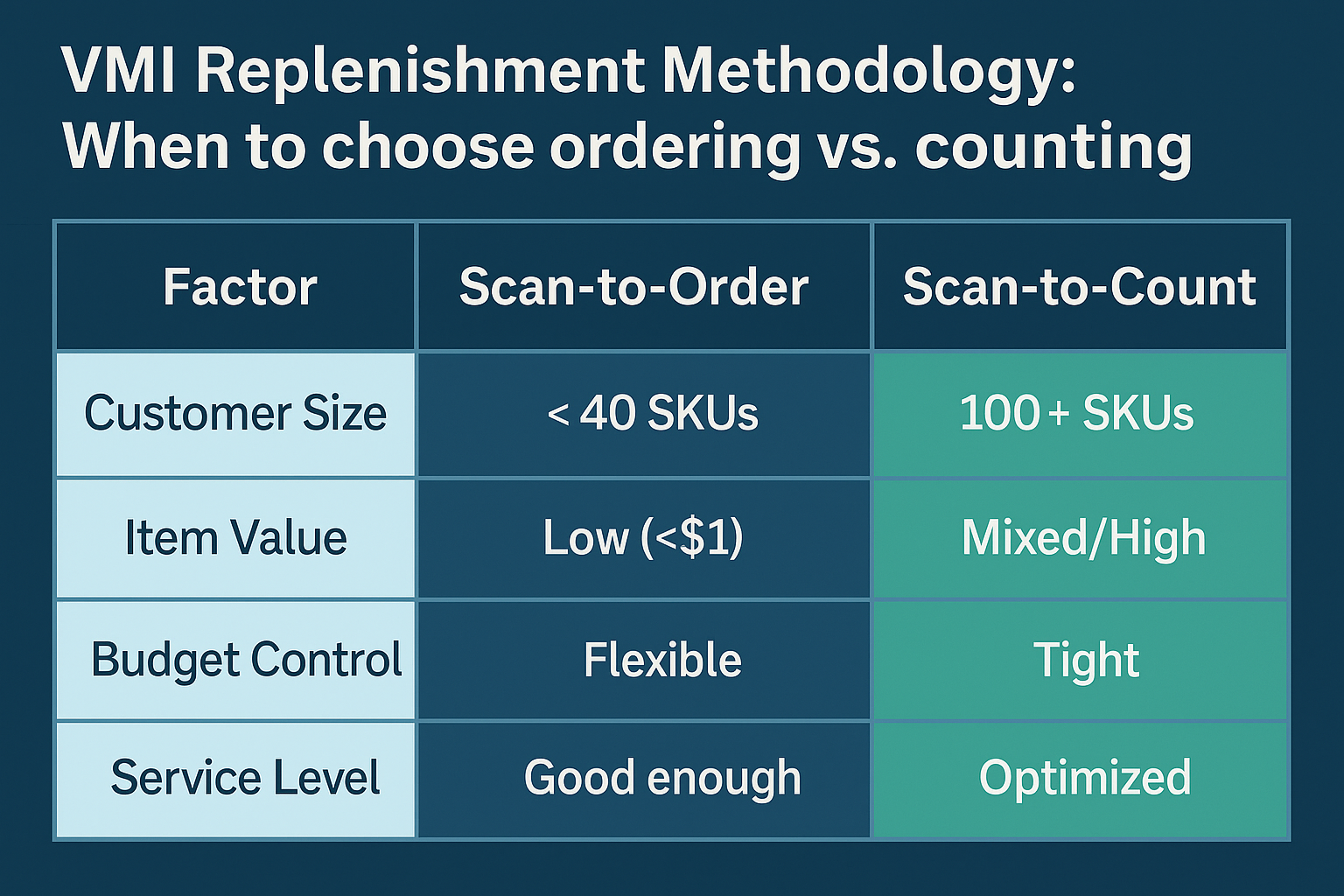When to Choose Cycle Counting vs. Ordering to Trigger VMI Replenishment Orders

By Rock Rockwell, CEO, eTurns
I wish more distributors would appreciate how much better it is to do cycle counting versus ordering when they set up their new vendor-managed inventory (VMI) app to manage point-of-use (stockroom, clinic, jobsite, vehicle, etc) inventory for customers.
They often default to scan-to-order processes without understanding the long-term implications.
It seems logical — VMI representatives walk stockrooms, use their judgment to identify what needs replenishment, scan QR codes with the VMI app, and place orders. Simple, familiar, but, in most cases, ordering is not as good as counting if the goal of the VMI replenishment program is to build strategic customer relationships.
Today, I want to share my perspective on when each method makes sense, give you a practical decision framework based on real-world implementations, and explain why this choice determines whether you become a strategic partner or commodity supplier.
“One approach treats you as a vendor creating orders; the other positions you as a partner optimizing their point-of-use replenishment operations.”
Understanding the Two Approaches: Ordering vs. Counting
Ordering
Scan-to-Order relies on VMI reps using visual judgment to identify items needing replenishment. The process is straightforward: walk the stockroom, assess what looks low, use a mobile VMI app to scan the QR code, and place any quantity on order.
Picture your rep walking a customer's MRO stockroom, seeing a bin that looks half-empty, and scanning to order their usual 24-piece case. It's essentially a digital clipboard replacing paper order forms—digitization without optimization.
Scan-to-order still beats manual (spreadsheet, clipboard) VMI in these ways:
- 10x faster to scan the bin versus walking back to a computer to key in order
- VMI apps will transmit the digital order with vital info the rep doesn’t need to add each time, such as: item #, reorder quantity, product location
- Control of user permissions
- Reporting
Cycle Counting
Scan-to-Count involves systematic counting of actual on-hand inventory levels with analytics-driven ordering decisions. Representatives count actual quantities, the VMI app compares these to optimized min/max levels, and the system determines precise re-order quantities.
Same stockroom, but now your rep counts 8 units, the VMI app shows a minimum of 12 and a maximum of 36, and automatically orders 24 to reach the optimal level, taking into account package quantities. Data drives decisions, not gut feelings.
The difference isn't just operational accuracy—it's strategic positioning. One approach treats you as a vendor creating orders; the other positions you as a partner optimizing their point-of-use replenishment operations.
"In the past, I spent at least two hours a day personally counting materials for the next day's jobs. With eTurns, it only takes me 5 minutes every two weeks -- it gives me data on usage, quantity on hand, min/max levels and much more."
When Each Method Makes Sense
In my experience, scan-to-order works well for specific scenarios, but most distributors apply it too broadly.
Ordering (Scan-to-Order) makes sense when:
- You're serving small customers with under 40 SKUs
- Items are mostly low-value (under $1 each)
- Usage patterns are infrequent or unpredictable
- The customer explicitly prefers simplicity over optimization
- Your representative has deep product knowledge and a strong relationship
Cycle Counting (Scan-to-Count) is better for:
- You’re serving large customers and managing 100+ SKUs
- Auto-replenishment
- High-value items or customers with tight budget controls
- Predictable consumption patterns
- Customers concerned about cash flow and inventory carrying costs
- Complex stockrooms with multiple item categories
Here's my quick reference guide:

The key insight? Most distributors choose scan-to-order for operational convenience, not strategic value. They're optimizing for today's simplicity instead of tomorrow's competitive advantage.
Why Cycle Counting (Scan-to-Count) Creates Distributor Value
I've seen the operational benefits firsthand across hundreds of VMI implementations. Scan-to-count delivers these operational benefits for distributors:
Operations benefits of Cycle Counts:
- better re-ordering accuracy by tracking actual usage data from the point-of-use
- fewer stockouts, emergency orders, and rush deliveries
- better inventory turns with lower inventory levels and reduced obsolescence,
- consistently high service levels regardless of rep experience.
The financial benefits are even more compelling. Customers find it easier to stay within budgets when orders are analytics-driven rather than judgment-based. Their carrying costs decrease as excess inventory disappears. We consistently see 30% increases in same-customer VMI spend as end customers (a.k.a buyers) transfer more purchasing to distributors providing a VMI process that optimizes inventory levels.
Financial benefits of Cycle Counts (for a distributor’s customers):
- helps customers stay within budgets
- optimized inventory levels with min/max analytics
- reduced carrying costs from reduced inventory levels
Financial benefits of Cycle Counts (for a distributor):
- Distributors often see a 30% increase in same-customer VMI spend as customers transfer purchasing to distributors providing optimized inventory levels
But the real competitive advantage comes from increased service levels and stickiness.
Scan-to-count gives you near real-time visibility into consumption patterns, enabling data-driven conversations with customers.
Most importantly, it differentiates you from competitors still using basic scan-to-order approaches. While they're competing on price and availability, you're competing on value creation and optimization.
Case study: Distributor Switches from Ordering to Counting to Save Customer Account
A customer of ours who is a medical distributor came to us a year ago with the classic problems that arise from using ordering as a VMI replenishment method. One of their larger customers constantly complained about excess inventory tying up cash flow, while simultaneously experiencing stockouts on critical items.
They almost lost the account.
When VMI reps use ordering instead of counting, the item that is scanned and the quantity that is ordered is 100% based on judgment instead of analytics. Sometimes the rep can order too much by accident or on purpose to make their month-end numbers. Without a VMI app guiding the rep through a counting process, bins can get missed and stockouts can happen.
This distributor was stuck in a cycle of emergency orders and customer frustration about stockouts.
Within six months of switching to eTurns TrackStock and using our VMI app for cycle counts, their customer stockouts were virtually eliminated, VMI spend increased 30%, and complaints about excess inventory disappeared entirely.
They went from order-taker to strategic partner.
The VMI rep knows exactly what to count because TrackStock guides him and identifies if he missed counting an item. The quantities ordered are determined by current on-hand quantities and AI-tuned minimums and maximums. Orders happen only when on-hand quantities are less than the minimum.

My Take: Choosing the Right Tool for the Job
Don't default to scan-to-order just because it seems simpler. Think about where you want the customer relationship to be in three years. The methodology you choose determines whether you're a vendor or a partner.
I recommend starting with pilot customers who already value optimization. Use their fiscal year to set cycle counting schedules, making the analytics feel integrated with their planning processes. Show ROI through inventory carrying cost reductions—when customers see $50,000 in annual savings from optimized inventory levels, the value becomes undeniable.
Position analytics as a competitive advantage, not complexity. Frame it as "We use data to optimize your cash utilization" rather than "We need to count everything systematically."
The distributors winning long-term customer loyalty understand that scan-to-count isn't just about inventory accuracy. It's about demonstrating genuine investment in customer success through measurable value creation.
The Future of VMI Methodology For Point-of-Use Inventory Replenishment
Manual ordering won't disappear entirely, but its role will shrink dramatically. The economic advantages of counting and IoT automation are too compelling to ignore.
Technology costs continue declining while labor costs increase. The math increasingly favors automated solutions.
Cycle counting with your VMI scanning app now allows you to move more easily to IoT automation of cycle counting in the future, such as through TrackStock SensorBins, weight sensors that constantly measure quantity on hand and trigger auto-replenishment when weight falls below a minimum.
Distributors who master this progression from ordering to counting to IoT automation will dominate their markets. Those who cling to outdated ordering processes will lose customers to competitors offering superior analytics and optimization.
The choice is clear: optimize for customer outcomes, not distributor convenience.
The Strategic Choice
The choice between these methods isn't just operational—it's strategic. Your VMI methodology determines your competitive position in an increasingly sophisticated and competitive market.
Distributors using scan-to-count with analytics are building competitive moats. Their customers become sticky because switching suppliers means losing optimization value that directly impacts their bottom line.
Meanwhile, distributors stuck in scan-to-order mentalities might find themselves competing on price and availability. They become commodity suppliers in a market increasingly focused on optimization and partnership.
The VMI market is projected to grow from $3.9 billion in 2023 to $6.3 billion by 2030. Distributors who position themselves as optimization partners rather than order fulfillers will capture a disproportionate share of this growth.
Ready to discuss VMI strategy for your customers? Contact eTurns for a free consultation on stockroom VMI methodology selection and implementation. We'll show you both the Scan-to-order and Scan-to-count approaches in the TrackStock app and help you determine which customers are ready for optimization-driven partnerships.
What's been your experience with VMI methodologies? Share your success stories or challenges in the comments below.



